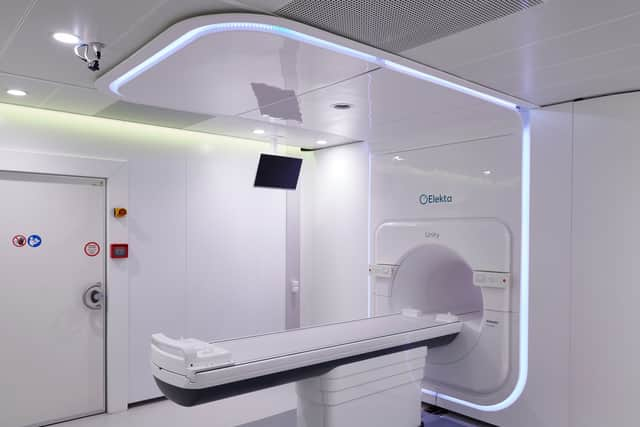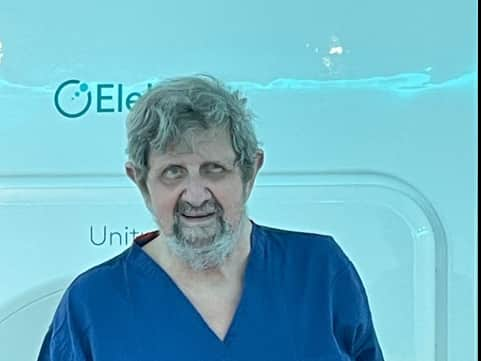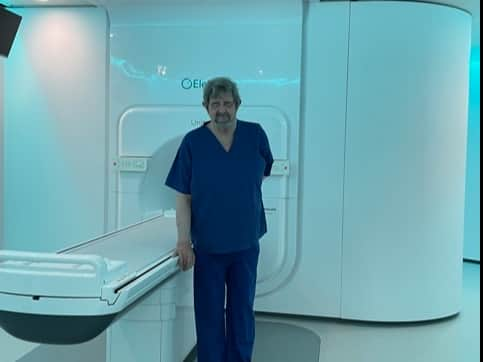UK first for Manchester cancer hospital The Christie as it pioneers new high-tech treatment
and live on Freeview channel 276
The Christie NHS Foundation Trust has used state-of-the-art technology to treat a cancer patient in the UK for the first time.
Barry Staniforth, 81, secured a place in the medical record books when he was treated in Manchester using the Elekta MR-guided linear accelerator (MR-linac) machine.
Advertisement
Hide AdAdvertisement
Hide AdThe technology performs real-time MRI scans while X-ray beams target the tumour, making it more accurate and reducing side effects.
What is the MR-linac and how does it work?
The MR-guided linear accelerator (MR-linac) combines magnetic resonance (MR) scanning and tumour-busting radiotherapy to deliver magnetic resonance radiotherapy in one hi-tech package.
Being able to more specifically target tumours and avoid more healthy tissue around them means the machine can use target X-rays better.


The £5.3m machine was part-funded by donations to The Christie charity.
Advertisement
Hide AdAdvertisement
Hide AdThe Christie’s specialist lung oncology team, headed up by Dr Ahmed Salem and Professor Corinne Faivre-Finn, has been overseeing its first outing to treat a patient.
The Christie’s experts have been supported by the MR-Llnac clinical lead Professor Ananya Choudhury, consultant research radiographer Dr Cynthia Eccles and physics lead Dr Rob Chuter.
The research team is also based at The University of Manchester.
The treatment was part of the Momentum trial which is a worldwide radiotherapy trial using the MR-linac.
Advertisement
Hide AdAdvertisement
Hide AdIt aims to target a wide range of cancers to find out which react best to the treatment.
After that, it is hoped it will be rolled out across the globe.
The trial is being overseen by Dr Eccles and the MR-linac team at The Christie and supported by the NIHR Manchester Biomedical Research Centre.
Who was the first patient to receive MR-linac treatment?
Father-of-two Mr Staniforth, who lives with his wife Pam in Sandbach, became the UK’s first patient to receive treatment using the MR-linac machine after being diagnosed with lung cancer.
Advertisement
Hide AdAdvertisement
Hide AdDespite the Covid-19 pandemic Mr Staniforth was quickly referred to The Christie for treatment.


He then received four weeks of radiotherapy to treat his lung cancer using the pioneering Elekta MR-linac machine.
Mr Staniforth worked as a social worker before then doing for another 17 years as a member of staff at Marks and Spencer until he retired aged 79 on New Year’s Eve 2019.
He is now looking forward to being able to spend time with his grandchildren.
What did Mr Staniforth say?
Advertisement
Hide AdAdvertisement
Hide AdMr Staniforth said: “There is a lot of negativity toward lung cancer but I have to say it is a privilege to be able to be treated at The Christie using such amazing treatment.
“It really lifts your spirits when you have such confidence in the people looking after you. And to be able to help science along the way is an even better feeling.


“The pandemic has been really hard and the added burden of lung cancer obviously affects you but I have been so lucky to be able to have such an amazing medical team looking after me.
“The care I received has been marvellous. It seems daft, but I actually looked forward to going in for my treatment. The staff are like friends and I felt so reassured that they were treating me.”
What did the team at The Christie say?
Advertisement
Hide AdAdvertisement
Hide AdDr Salem said: “The MR-linac’s unique ability to provide real time scans of the tumour and healthy tissues while treatment is being delivered provides an opportunity to improve radiotherapy accuracy and reduce side-effects in selected patients.
“We hope that Barry will be the first of many lung cancer patients to have treatment on this innovative machine.
“It is a privilege to be part of the team that made this possible.”
Leading the way in terms of using technology to treat cancer
Advertisement
Hide AdAdvertisement
Hide AdThe roll-out of the MR-linac machine is not the first time The Christie has made headlines for pioneering treatments.
The hospital opened opening the UK’s first NHS high-energy proton beam centre in 2018.
It is now one of only two sites worldwide to offer both these pioneering radiotherapy treatments.
Comment Guidelines
National World encourages reader discussion on our stories. User feedback, insights and back-and-forth exchanges add a rich layer of context to reporting. Please review our Community Guidelines before commenting.
